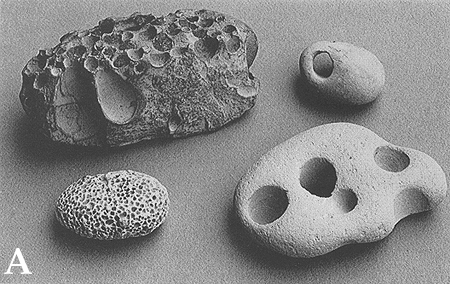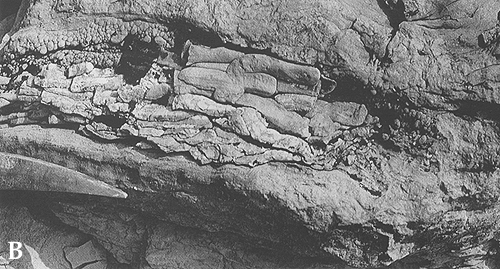

Traces of boring organisms
Plate 161


Traces of boring organisms
Plate 161
When organisms exert a boring activity, which is a chemical or mechanical attack, or a combination of them, scientists speak of bio-erosion, instead of bioturbation. Bioturbation is part of soft-sediment deformation processes, whereas bioerosion implies the disintegration or dissolution of hard or fragile substances (minerals, rock, wood). Dissolution affects mainly carbonate minerals, and is operated by acids secreted by organisms.
Plate 161 A shows perforated pebbles of various provenances, with holes of variable size. The pebbles were collected from beaches, where boring organisms (lithophagous ) live mostly in the intertidal zone. They are represented chiefly by mollusks (e.g., Lithodomus ), whose shells can still be found within the cavities. Bored pebbles are thus paleoenvironmental indicators, but attention must be paid to their potential reworking. Beach gravel can be involved in subaqueous slides or be captured by the head of a submarine canyon; it is then resedimented and becomes incorporated in deep-water deposits. The perforations are filled by sediment but remain preserved as witnesses to a former stay of the pebbles in the littoral zone (the gravel beach can be completely destroyed, leaving only this indirect evidence of its existence). When streams empty their coarse load directly onto slopes and canyons, no bored pebbles are found.
Micro borings have been observed in thin sections of carbonate rocks; they are made by algae, fungi, etc. No documentation of these microstructures is presented here.
The strange structure of picture B results from the activity of wood-eating (xilophagous ) organisms, in particular the mollusk Teredo. Their valves assume a tubular shape, which is preserved here by filling sand (fragmentary remnants of carbonate shell are still attached to the molds). The black speckles and strings indicate carbonized wood (lignite), and the surrounding rock is a turbidite sandstone (from the Marnoso-arenacea Formation). Apparently, the Teredo individuals were inside a piece of wood when it was carried in suspension by a turbidity current; very likely, they were still alive when sand deposition entombed them.
Minor structures, with the form and size of peas or pills, developed along the contact between the wood and the embedding sand. Their origin is uncertain (gas escape? liquefaction?).
| Photo: A G. Piacentini 1970. |